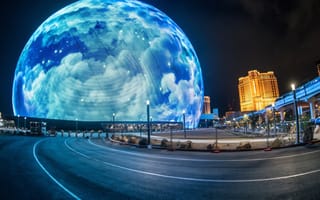In Paradise, Nevada, near the Las Vegas strip, sits the largest spherical structure and biggest LED display in the world — an entertainment venue known simply as the Sphere.
The Sphere’s outer shell, dubbed the Exosphere, lit up on July 4, 2023, projecting animations of a waving American flag before showing off its curves as an eyeball, basketball and even Earth itself.
And on September 29, 2023, the Sphere officially debuted, with the first live performance of Irish rock band U2’s three-month residency.
Curious crowds are eager to see what’s inside the one-of-a-kind orb — and what exactly makes it so special.
What’s So Impressive About the Vegas Sphere?
Serving more than just meme material, the orb-like structure is a technological marvel. The 366-foot-tall, 516-foot-wide stadium’s eye-catching wraparound screen, which spans 580,000 square feet, is made up of 1.2 million hockey-puck-sized LED lights, each containing 48 individual diodes capable of flashing 256 million different colors.
Inside the dome, the ultra-high, 16k-resolution floor-to-ceiling LED screen complements an advanced spatial-audio system based off of Holoplot’s X1 speaker module. Complete with 168,000 surround-sound speakers, this technology sonically transports listeners via wave field synthesis, a technique that essentially recreates real sound to make it seem like you’re closer to the action, and beamforming, which delivers a curated acoustic experience to each seat in the venue as individual speakers respond to the same input in different ways. With sound emitting from behind the screens and through the floorboards, the idea is to vibrationally submerge audience members in ultra-sensory effects in order to simulate anything “from the swell of a tide to a total shift in gravity.”
Of the 20,000 total spots in the arena — standing room included — half are designed with built-in seat haptics that literally enable attendees to “feel” atmospheric effects. Chairs shake and tilt. Pipes and hoses shoot heated steam and compressed air to imitate a warm breeze or cast a scent, while temperature and humidity controls recreate blizzards and desert scenes.
For interactive events and general comfort, the sphere is equipped with 1,1000 access points in its Wi-Fi system, serving 25 megabits per second.
What Is the Vegas Sphere Used For?
The $2.3 billion LED orb is primarily used to host concerts, award shows, cinema and sporting events. It is designed to deliver immersive, multi-sensory experiences “unlike anything else” (to do this, design firm Populous combined a multitude of 4D technology). However, the way in which artists use the space will remain open-ended.
Upcoming events include a humanoid-robot-led tour of the premises and a screening of movie director Darren Aronofsky’s part-sci-fi, part-nature documentary Postcard From Earth.
Guy Barnett, the senior vice president of brand strategy and creative development at Sphere Entertainment, noted that the ogle-worthy building serves as more than just a screen or billboard.
“It is living architecture,” Barnett said in a press release, that will allow artists to explore uncharted territory and unlock “possibilities … to create compelling and impactful stories to connect with audiences in new ways.”
In fact, the entertainment group has already launched its own production company, Sphere Studios, to produce immersive content uniquely fit for the curved screen and build the technology from scratch.
Its first camera system, called the Big Sky, does the job of 10 cinematic cameras in one, using a single 316-megapixel HDR image sensor to capture imagery at up to 120 frames per second in 18K resolution. These cameras are coupled with an image processing software, called SphereLab, that runs on GPU-accelerated RAW processing.




